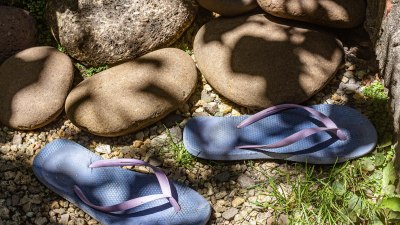The Great Flip-Flop vs. Hiking Boot Debate You Didn’t Know You’d Have
Explore the ultimate showdown between flip-flops and hiking boots for outdoor adventures. Which footwear wins?

Footwear is an essential component of our daily lives, impacting comfort, style, and even health. For outdoor enthusiasts, the choice of footwear becomes even more critical, especially when debating two popular options: flip-flops and hiking boots. While these two types of footwear serve distinct purposes, their contrasting designs and functionalities have sparked a passionate debate among adventurers. In this article, we'll explore the merits and downsides of flip-flops and hiking boots to help you navigate your own choices and possibly settle this ongoing debate.
Understanding the Basics of Each Footwear Type
Flip-flops are casual footwear primarily designed for comfort and convenience, often crafted from rubber or foam. They typically feature a flat sole and a Y-shaped strap that goes between the toes. Perfect for beach outings, casual gatherings, or quick errands, flip-flops are favored during warm weather and are often characterized by their lightweight nature.
On the other hand, hiking boots are engineered for outdoor adventures, offering robust support and protection. Made from stiff materials, hiking boots feature cushioned insoles, ankle support, and rugged outsoles designed to provide traction on various terrains. Whereas flip-flops are suited for leisurely settings, hiking boots are tailored for performance and durability in challenging environments.
Comfort: The Heart of the Debate
Comfort is subjective, and the best choice often depends on the context. Flip-flops are lauded for their ease of wear, making them an ideal choice for relaxing or walking short distances. Many people appreciate how flip-flops allow their feet to breathe, making them feel cool and unrestricted. However, this lack of support can lead to discomfort in the long run, especially for those with flat feet or existing foot conditions.
Conversely, hiking boots excel in providing comfort during extended outdoor activities. Designed with cushioning and arch support, they help prevent fatigue and discomfort while navigating trails. Their supportive structure can significantly reduce the risk of injuries such as sprains or blisters, which are common with inadequate footwear. Although initially heavier and stiffer than flip-flops, many users find that the investment in quality hiking boots pays off during long excursions.
Style and Versatility
Style versatility plays a significant role in the footwear debate. Flip-flops embody a laid-back, beachy vibe that appeals to many, especially in summer. With various colors, styles, and patterns available, flip-flops can be a fun accessory to any casual outfit. However, their versatility is somewhat limited. They are not suitable for formal occasions or environments where closed shoes are required.
In contrast, while hiking boots may not be perceived as stylish for everyday use, they come in multiple designs that can be fashionable while remaining functional. Many modern options blend outdoor utility with chic aesthetics, allowing wearers to transition from the trail to a more urban environment with ease. Additionally, hiking boots can often be worn in various weather conditions, including rain and snow, making them a practical choice for more than just hiking.
Durability and Protection
When it comes to durability and protection from outdoor elements, hiking boots have a clear advantage. Designed with robust materials, these boots are built to withstand scrapes, bumps, and adverse weather conditions. They provide a significant protective layer against rocks, roots, and uneven surfaces that one might encounter on a trail.
Flip-flops, while convenient for short-term use, fall short in durability and protection. The thin sole provides minimal cushioning against sharp objects and rugged terrain. Prolonged use, especially in rough settings, can lead to foot injuries, sunburns, or stubbed toes. Therefore, choosing flip-flops as your primary footwear for adventures may not be the best idea if you plan to traverse demanding paths.
Safety Considerations
Safety should never be undervalued when engaging in any outdoor activities. Hiking boots are designed with safety features such as ankle support, slip-resistant soles, and water-resistant materials. This safety mechanism is crucial for preventing accidents while walking on uneven terrain or navigating wet surfaces. Wearing hiking boots can bolster confidence on the trail, allowing for greater focus on the scenery rather than potential hazards.
In stark contrast, flip-flops offer little in terms of safety features. The flat, open design provides minimal grip, making slips and falls more likely. Additionally, exposed toes are vulnerable to stubbing, scratching, or even encounters with insects. Finally, prolonged use of flip-flops can lead to issues like plantar fasciitis due to lack of arch support and inadequate shock absorption, presenting further risks for those who engage in any physical activity.
Environmental Factors
Choosing the right footwear also depends on the environmental context when you venture outdoors. If you're heading to a beach, pool, or casual picnic, flip-flops are often the ideal choice, allowing for easy on-and-off access while keeping your feet cool. They are typically water-resistant, lightweight, and highly portable, making them a favorite choice among summertime activities.
On the other hand, if your planned outing involves hiking on rocky terrain, muddy paths, or chillier weather conditions, hiking boots will be your best bet. Their sturdy construction and insulation (in some models) support a more enjoyable hiking experience, as they repel water and protect against debris. Additionally, hiking footwear can improve overall safety by providing better traction to prevent slips on wet or loose surfaces.
Cost Considerations
Cost is another factor worth discussing in the flip-flop vs. hiking boot debate. Generally, flip-flops are significantly more affordable, with a wide range of prices available. You can find decent pairs for under $20, making them accessible for casual users who may not invest in fancy outdoor gear. However, cheap flip-flops can also come with comfort and durability compromises, leading to potential replacement costs if they wear out quickly.
Hiking boots, being more specialized footwear, often come with higher price tags. A quality pair may set you back anywhere from $100 to several hundred dollars, depending on the brand and features. While the initial investment is larger, consider how often and in what conditions you will use the boots. If you plan on engaging in hiking regularly, purchasing high-quality hiking boots can be considered a smart investment that can enhance your outdoor experiences while lasting for years.
In the great flip-flop vs. hiking boot debate, there may not be a one-size-fits-all answer. Each footwear option serves its own purpose and meets different needs depending on the activity at hand. For leisure, casual outings, and beach days, flip-flops reign supreme, while hiking boots are essential for serious trekkers or adventurers. As a rule of thumb, if you're engaging in rigorous outdoor activities, opt for hiking boots to ensure safety, comfort, and durability. Conversely, keep flip-flops close for those relaxed, fun-filled moments where convenience reigns. Ultimately, understanding the strengths and weaknesses of each type can help you make the right choice for your footwear needs.











